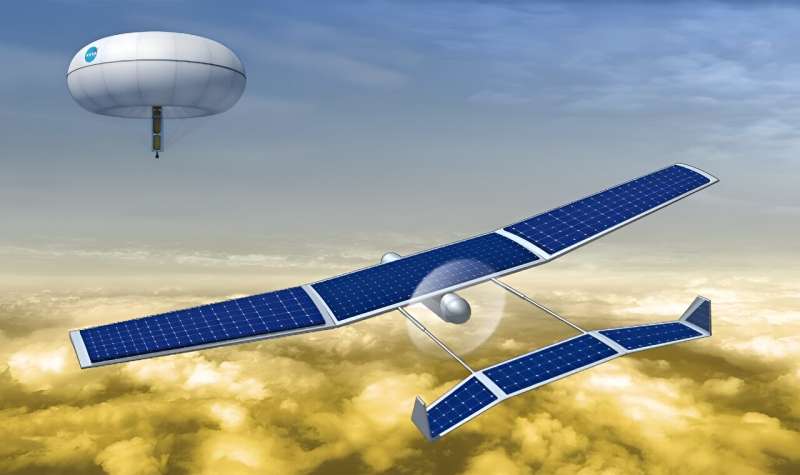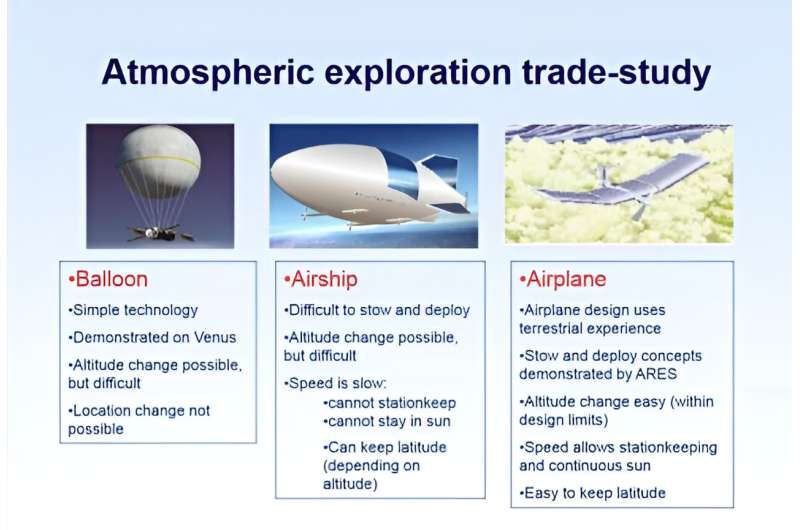This article has been reviewed according to Science X's editorial process and policies. Editors have highlighted the following attributes while ensuring the content's credibility:
fact-checked
trusted source
proofread
NASA selects a sample return mission to Venus

In Dante Alighieri's epic poem The Divine Comedy, the famous words "Abandon all hope, ye who enter here" adorn the gates of hell. Interestingly enough, Dante's vision of hell is an apt description of what conditions are like on Venus. With an average temperature of 450°C (842°F), atmospheric pressures 92 times that of Earth, and clouds of sulfuric acid rain to boot, Venus is the most hostile environment in the solar system. It is little wonder why space agencies, going all the way back to the beginning of the Space Age, have had such a hard time exploring Venus' atmosphere.
Despite that, there are many proposals for missions that could survive Venus' hellish environment long enough to accomplish a sample return mission. One such proposal, the Sample Return from the Surface of Venus, comes from aerospace engineer and author Geoffrey Landis and his colleagues at the NASA Glenn Research Center. Their proposed concept was selected for this year's NASA Innovative Advanced Concepts (NIAC) program. It consists of a solar-powered aircraft that would fashion propellant directly from Venus' atmosphere and deploy a sample-return rover to the surface.
The concept of a solar-powered airplane exploring Venus is one Landis and his colleagues have been developing for roughly 20 years. In his first paper, released in 2001, "Exploring Venus by Solar Airplane," Landis indicated how a solar-powered airplane could safely explore above the cloud deck on Venus—roughly 60 km (37 mi) above the surface. At this altitude, he claimed, the solar intensity is "comparable to or greater than terrestrial solar intensities," and the atmospheric pressure makes flight easier than on Mars.
He also noted how Venus's slow rotation would ensure that the airplane would be exposed to continuous sunlight and wouldn't require stored energy for night-time flight. In a paper released in 2003, "Atmospheric Flight on Venus: A Conceptual Design," Landis and colleagues from NASA Glenn and the University of Illinois shared specifications for a potential fleet of solar-powered aircraft. Two years later, this was followed by "Venus atmospheric exploration by solar aircraft" in 2005, where Landis and these same colleagues advocated for a mission to explore Venus' atmosphere 50 to 75 km (31 to 47 mi) from the surface.
This region is part of Venus' "middle atmosphere," where temperatures range from -100°C (-148°F) to about 30–70°C (86–158°F), and exposure to sulfuric acid rain would be minimal. What's more, thanks to Venus' slow rotational period (243 days), a solar-powered aircraft flying above the cloud deck would also be exposed to perennial daylight. As Landis told Universe Today via email:
"The middle atmosphere of Venus is nearly the most unknown region of the planet, and simply flying an airplane in this region could lead to some interesting science. Aircraft have the advantage that they have complete control over flight; you go where you want to go, not where the wind sends you. For the sample return, the airplane gives us the option to do a controlled rendezvous with the return rocket."
In a subsequent paper released in 2004, "Robotic Exploration of the Surface and Atmosphere of Venus," Landis presented a mission architecture that included both surface robots and a solar-powered airplane. Whereas the robots would explore the surface for 50 days (their full lifetime), the aircraft would probe Venus' atmosphere between 100 km (62 miles) and 60 km (37 mi) above the surface—i.e., just above the cloud deck. From this point onward, Landis and his colleagues at NASA's Glenn began to consider how advances in materials science would enable a mission to the surface.
In 2008, Landis and his team presented their concept to NASA's Science and Technology Definition Team (STDT) for Venus. As they revealed, the concept would have a wingspan of 9 meters (29.5 feet) and measure 7 m (23 ft) long, with a foldable design that would allow it to fit inside an aeroshell. The aircraft would unfold once it reached Venus and would have many advantages over other airborne concepts—such as balloons and solar-powered airships. Several studies by Landis and his team followed, and the design has evolved with time.

Suffice it to say the concept has evolved considerably over the past 20 years and owes its existence to many different sources. In its latest version, which was selected for Phase I NIAC development, the aircraft relies on carbon monoxide rocket technology and generates its own propellant directly from Venus' atmosphere. As Landis told Universe Today, this concept is still in line with the original idea and could enable the first sample-return mission from Venus:
"[T]he first paper I did, looking at Venus airplanes, was back in 2001, when we were still hoping it would be exciting to celebrate the centenary of the Wright Flyer with the first flight on another planet. The solar airplanes we looked at in the past, though, were for flight in the upper atmosphere, not in the hot near-surface atmosphere. But high-temperature electronics are being developed at NASA Glenn and elsewhere, and it was reasonable to start thinking whether it's possible to actually fly all the way to the surface and back up."
"Separately, we were looking at in-situ propellant production for other missions, and I started thinking, where else could we think to apply in-situ propellant production that hasn't already been analyzed, and particularly, where could it make a real difference in an otherwise nearly impossible mission?" said Landis. "The Venus sample return stemmed from that kind of thinking."
The aircraft would be paired with a surface element that takes advantage of high-temperature surface systems. As explored in previous articles, scientists have spent years working on concepts that could operate in Venus' hellish environment. This has led to a diverse range of proposals that incorporate "steampunk" technology, a wind sail, or special electronic systems that can withstand the extreme heat and pressure of Venus' atmosphere. In addition, the aircraft could also obtain atmospheric samples, perhaps settling the debate on whether there could be life in Venus' clouds.
"For the surface sample, this would be primarily a geology and mineralogy mission," said Landis. "An atmospheric sample would also have tremendous scientific value for astrobiology and would be a good stepping stone to the more difficult surface sample mission. The recent discovery of phosphine in the clouds of Venus makes the idea of a cloud sampler even more exciting."
With Phase I funding secured, Landis and his colleagues are now focused on turning the conceptual mission architecture into detailed designs. As Landis explained, this will consist of a step-by-step concept of operations (CONOPS), where all the mission components will be combined to create a mass budget, produce some hard numbers, and show that it is feasible. Looking to the future, Landis and his colleagues hope that their proposal will lead to applications for aerial vehicles and exploration that go far beyond Venus and Mars:
"I do think that the next big step in planetary exploration, pioneered by the Mars "Insight' helicopter, is flight. In-situ resource utilization, although talked about extensively, has yet to be attempted on any solar system body (other than Earth). Putting these together should open doors to the exploration of many planetary bodies."
To learn more, check out the full list of NASA's NIAC 2024 selections here.
Provided by Universe Today




















